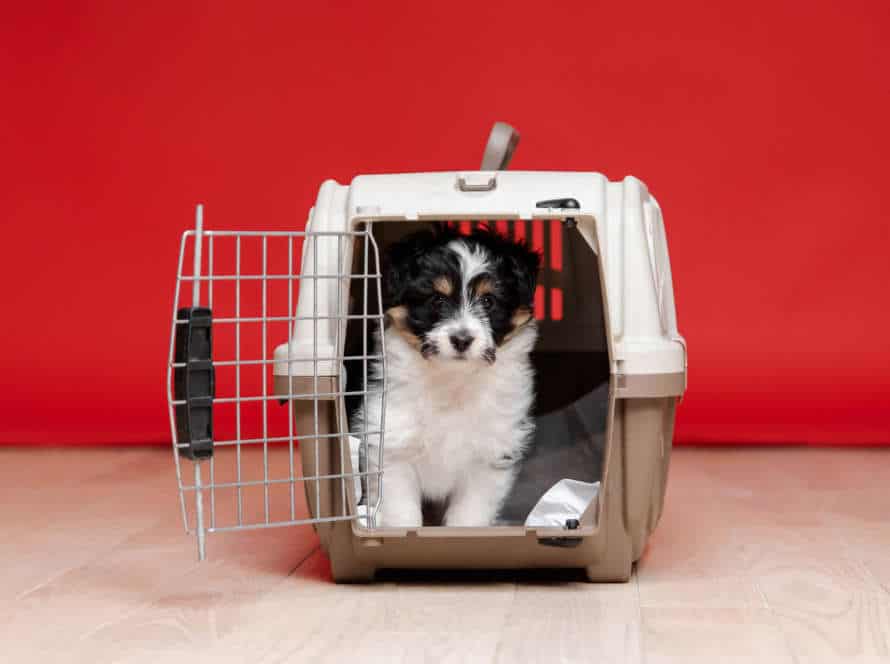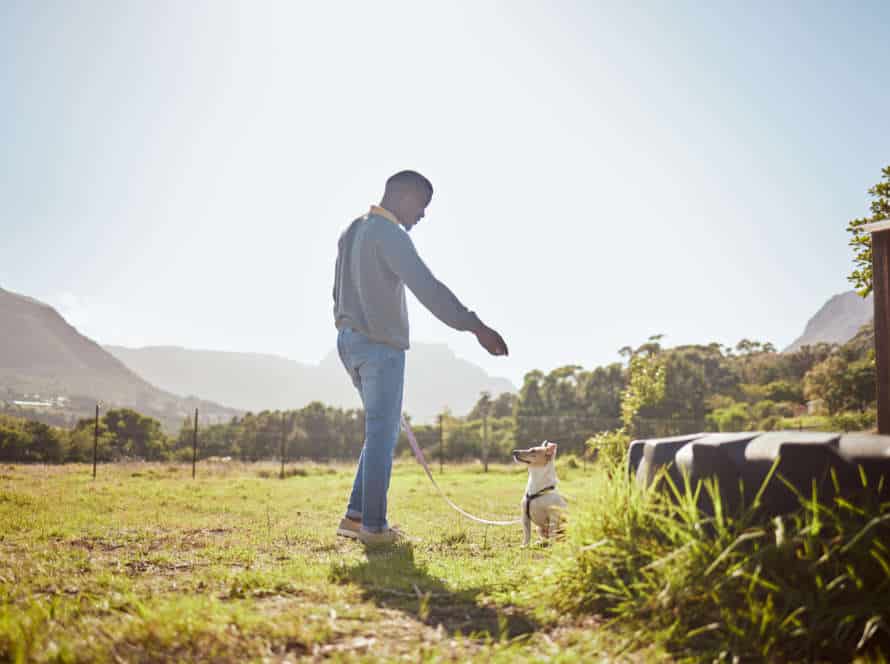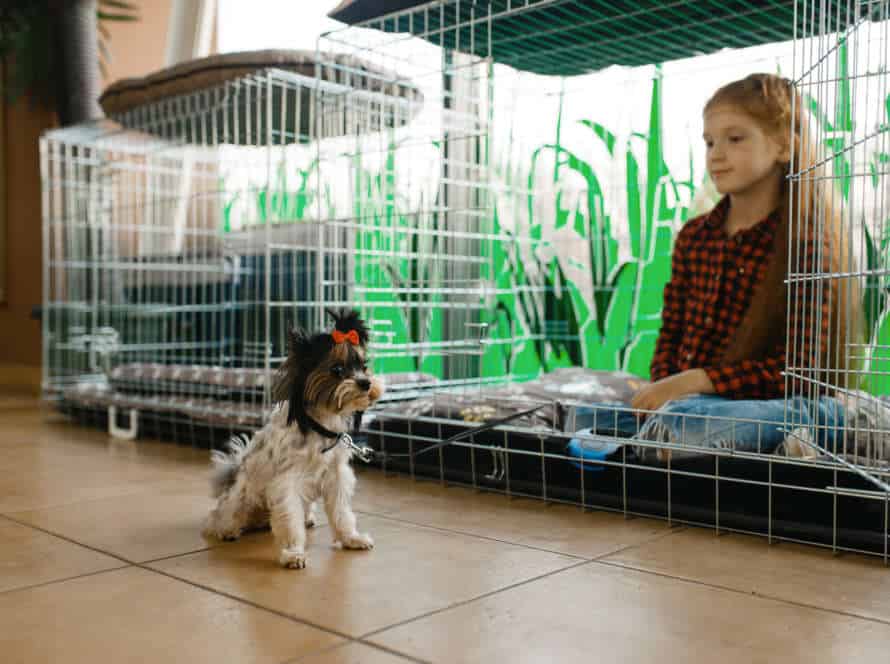Recognizing and Addressing Stress in Your Dog During Leash Training
It’s important to recognize and handle stress in dogs during leash training. Signs of stress could be pulling, lunging, whining, trembling, cowering or avoiding eye contact. If you spot any of those signs, it’s essential to find the root of the stress before proceeding with training.
Here are some tips:
- Prior to each session, provide exercise and playtime to help your pup release energy.
- Use positive reinforcement to encourage good behavior and build a relationship.
- Breaks are necessary to avoid overwhelming or tiring your pup.
- Gradually increase duration and distance of training, instead of pushing too hard.
Giving praise and encouragement is key! Leash training takes time and patience.
Understanding Your Dog’s Body Language
Comprehending your pup’s body language is essential for understanding and managing stress while leash training. It’s vital to recognize the signs they give, to provide a positive, low-stress learning environment. These signs include facial expressions, body posture, and vocalizations. Being aware of your dog’s body language gives you the ability to respond to their needs.
Let’s explore the different signs to be on the lookout for:
Signs of Fear, Anxiety, and Stress in Dogs
As a pup parent, it’s key to know when your furry pal is feeling fear, anxiousness, or stress during leash training. Signs of stress in your doggo may include:
- Excessive panting, even when it’s not hot.
- Whining or whimpering.
- Cowering or shrinking away from you.
- A tucked tail or raised hackles.
- Avoiding eye contact or looking away.
- Licking their lips or yawning excessively, even when not tired.
If these signs are seen during leash training, take a break and let your pup have some time to de-stress. Training should always be a pleasant experience, so be patient and give lots of praise and reward for good behaviour.
Understanding Subtle Signs of Discomfort in Dogs
Spotting subtle signs of unease in dogs is important for managing stress during leash training. Here are some common ones:
- Yawning or licking lips
- Panting when it’s not hot
- Turning head away/ avoiding eye contact
- Shedding a lot
- Lifting a paw/rolling to show belly
- Moving slowly/stiffly
If you see any of these, take a break and give your dog space, to relax. The leash training should be a positive, rewarding experience that promotes bonding with your dog.
A pro tip: start with short walks and gradually increase time and intensity, so your dog gets used to the idea of walking on a leash.
Identifying Stress Triggers in Your Dog
Dogs can get stressed and anxious for a variety of reasons. It’s important to know their triggers for successful leash training.
Common stress triggers for dogs are:
- Noises like fireworks or thunderstorms can startle them.
- New people, pets, or changes in routine can create insecurity.
- Pain, injury, or illness can also cause stress and agitation.
Pay attention to your pup’s body language. Signs of stress include: pacing, panting, drooling, ears back, tail tucked, yawning, lip-licking, or avoidance/cowering.
By recognizing these signs and understanding triggers, you can help your pup feel more comfortable and confident during leash training.
Pro tip: Reward your dog with treats and positive reinforcement for a great leash training experience.
Reducing Stress for Dogs During Leash Training
Leash training is important to teach your pup obedience and how to behave in public. Your pup may become overwhelmed or stressed during the training though. Recognize when your pup is stressed and take steps to reduce it. This will ensure your pup learns in a positive way.
Gradual Desensitization to the Leash and Collar
Gradual desensitization to the leash and collar is a technique to reduce stress for dogs during leash training. Introduce your dog to the collar by allowing them to sniff it and explore it. Once they are comfortable, slowly introduce the leash. Place it on the ground and let them sniff it. Attach it to the collar and let them walk around inside the house for short periods. Gradually increase the duration. Then move to the backyard. Finally transition to outside walks. Watch for stress signs such as panting, pacing, or avoiding the leash. Slow down the training if needed. Offer positive reinforcement to make your dog more comfortable.
Positive Reinforcement Training for Dogs
Positive reinforcement training is a great way to reduce stress while leash training your pup. Focus on rewards and gentle guidance. Look out for signs of stress such as panting, yawning, or pulling away from the leash. Take breaks, offer treats or praise for good behavior. Use a harness instead of a collar to reduce stress on the neck. Be patient and consistent with your pup, providing plenty of encouragement and rewards for progress. These techniques will help your furry friend feel more relaxed and confident while learning leash walking.
Using Treats and Toys to Make Leash Training Fun
Treats and toys can make leash training more fun for dogs and lower their stress! Here’s how:
- Shorten training sessions.
- Use yummy treats to reward good behavior.
- Say a phrase like “let’s go” or give a gentle tug on the leash.
- Reward your pup often with treats and praise for walking beside you.
- Add interactive toys like tug ropes and balls to make it more fun.
- Be mindful of your pup’s stress levels. Take breaks or adjust training if needed.
Creating a Positive Leash Training Experience for Your Dog
Leash training can be a fun bonding time between a dog and its owner. But, it is essential to be aware of any stress your pup might show. Make sure the training is safe and pleasant. Here are some tips to make the experience positive:
- Start with a comfortable and secure collar or harness for your dog.
- Choose an appropriate leash for your dog’s size and strength.
- Begin training in a quiet, low-stress environment free of distractions.
- Use positive reinforcement, rewarding your dog with treats or praise for good behavior.
- Allow your dog freedom to explore, while still maintaining control of the leash.
- End each session on a positive note, with a treat or toy as a reward for good behavior.
Scheduling Regular Training Sessions
Regular training sessions are a great way to give your pup a positive leash training experience. Here are some must-know tips:
- Start with short, regular training to build confidence and prevent overwhelm.
- Use treats and praise to motivate and keep ’em engaged.
- Keep an eye on body language and behavior. Watch for signs like panting, yawning, or trying to escape.
- Take breaks when needed. Don’t push past comfort level.
- Slowly make it more difficult over time.
By following these steps and scheduling regular sessions, you can make leash training positive and rewarding for both of you!
Avoiding Overstimulation during Training
Leash training your dog? It’s important to avoid overstimulation! Stress can ruin your pup’s response.
Here’s how:
- Keep training sessions short and regular.
- Positive reinforcement; treats, praise, playtime.
- Look out for signs of stress; panting, shaking, hiding. Take a break when needed.
- Train in quiet, familiar areas.
Adopt these practices and techniques for a positive, stress-free experience!
Celebrating Small Wins and Progress in Training
Leash training your pup can be difficult and irritating. But, it is important to recognize and appreciate the small wins and progress. Here are some tips for celebrating progress:
- Train in short sessions, so as not to overwhelm your dog.
- Use treats and praise as positive reinforcement for good behavior.
- Take note of even the smallest improvement and give it a pat on the back.
- Be patient with your pup, and accept any complications as part of the learning process.
- Keep track of your pooch’s progress over time.
Pro Tip: Celebrating those successes will help keep you motivated and will make the experience more enjoyable for both you and your pup!
Knowing When to Take a Break from Leash Training
Leash training needs recognition of your pup’s stress signs. If they’re stressed, it’s time to pause. This’ll help ’em stay focused and learn. Let’s check out the key signs of stress and how to take a break.
Signs that Your Dog Needs a Break from Training
Leash training is vital for dog owners. But, it is important to recognize when your dog needs a break. Here are five warning signs:
- Lack of Interest: If your pup doesn’t seem keen even when you try to motivate them, they need a break.
- Aggression: If they act aggressively to people or other dogs, give them a break.
- Exhaustion: If your dog is tired with a long tongue, time for a break.
- Confusion: When they don’t understand what you want, take a break and clear things up.
- Anxiousness: Drooling, destructive behavior? Take a break and train them again.
Pro Tip: At the first sign of stress, give them a break. A content pup will learn and obey better.
How to Give Your Dog a Break from Leash Training
Leash training your pup is a must for obedience and safety. But, you need to recognize when your furry companion needs a break. Here are some signs of stress during leash training:
- Pulling away or resisting the leash.
- Whimpering, growling, or barking too much.
- Showing fear or anxiety, like trembling or cowering.
- Constantly licking its lips or yawning.
If your dog has any of these behaviors during leash training, it’s time for a break! Here are a few tips:
- Shorten training sessions.
- Give treats and praises for an interesting experience.
- Take your pup for a walk in a calm environment.
Remember, taking a break doesn’t mean quitting. It’s ok to pause, take some time off and then start again until your dog is ready.
How to Restart Leash Training After a Break
Restarting leash training after a break needs a different strategy. Here are some steps to make the switch smooth, and help your pup cope with any stress from before.
- Identify the cause: Find out what made them anxious. Was it other canines? Or too much going on? Knowing this lets you take action.
- Start with basic commands: Begin with easy ones like “sit” and “stay.” This helps your dog rebuild confidence, and trust.
- Gradual exposure: Introduce the leash gradually. Start in the home and progress to busier places.
- Positive reinforcement: Use treats or other rewards to make the leash a positive experience.
- Patience and consistency: Breaks are important. Make sure your pup’s wellbeing is your priority.
Frequently Asked Questions
1. How do I know if my dog is stressed during leash training?
A: Some signs that your dog may be stressed during leash training include pulling on the leash, panting excessively, yawning, and avoiding eye contact. Your dog may also try to escape the leash or exhibit other avoidance behaviors.
2. How can I help my dog feel less stressed during leash training?
A: It’s important to take things slow and make sure your dog feels comfortable every step of the way. Use positive reinforcement techniques, such as treats and praise, to encourage your dog to follow your lead. You can also try using a no-pull harness or other training aids to help your dog feel more secure.
3. What kind of leash should I use for leash training?
A: A four- to six-foot leash made of nylon or leather is ideal for leash training. Avoid retractable leashes, as they can be difficult to control and may make your dog feel insecure.
4. How long should I spend training my dog on the leash?
A: It’s best to start with short training sessions of 10-15 minutes and gradually work up to longer sessions as your dog becomes more comfortable on the leash. Be sure to take breaks frequently to give your dog a chance to rest and rehydrate.
5. What if my dog still seems stressed even after following these tips?
A: If your dog continues to show signs of stress during leash training, it may be helpful to seek out professional help. A certified dog trainer or animal behaviorist can assess your dog’s behavior and provide additional tips and techniques to help reduce stress during leash training.
6. Can stress during leash training lead to other behavior problems?
A: Yes, prolonged stress during leash training can lead to other behavior problems such as aggression, fear, or anxiety. It’s important to recognize and address stress early on to prevent these issues from developing.







